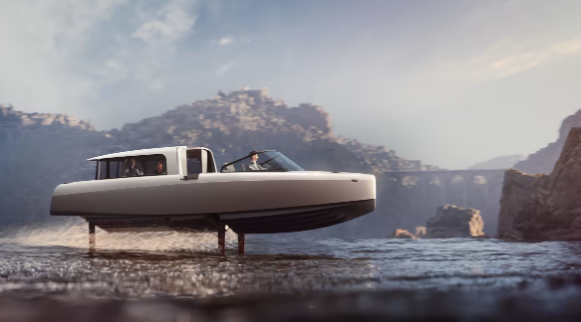Conventional speedboats — such as water taxis or yacht tenders — have big combustion engines and use huge amounts of fuel. As their hulls displace water, waves are formed that erode shorelines and damage cora; reefs and other sensitive ecosystems.
Other problems are oil spills, emissions, and sound pollution. According to reports on the Great Barrier Reef, the noise from boat engines can even cause fish to die prematurely from stress.
Gliding silently across the water, Candela’s 8.64mx2.55m (28'x8'), carbon-fiber hull P-8 Voyager barely leaves a trace on the water’s surface. Its hydrodynamically shaped foils form a tiny 5 cm high wake that is hardly noticeable by marine creatures or causes erosion to beaches or coral reefs. Yet, with its Candela C-POD motor at full rev, it tops out at 30 knots and has a range of 50nm at cruise speed — going faster and further than any other electric boat. And it doesn’t have to slow down for waves either: four-foot swells will hardly be noticeable for passengers enjoying the scenery from their air-conditioned panorama cabin.
The P-8 Voyager, which has a six passenger capacity, plus crew, was built in Sweden using Candela’s computer-guided foils, or underwater wings, that reduce energy consumption by 80% compared to traditional motorboats. Gliding above the friction of water, the P-8 Voyager draws only about 25 kW from its Candela C-POD motor when cruising at 20 knots.
The hydrofoils are the key to achieving long range and high speed in electric boats — the P-8 Voyager has two to three times longer range than any other electric speedboat — but the technology’s big boon is to the fragile marine environment and its inhabitants.
From Venice to the Bahamas, it’s absurd to travel in beautiful and fragile ecosystems in speedboats that burn 200 liters of petrol per hour and make huge wakes. With the Candela P-8 Voyager, Candela wanted to make a no-compromise electric exploration vessel. You have the performance, can cruise for well over two hours, but there’s virtually no negative impact on the environment, Erik Eklund, Candela’s chief executive of commercial vessels, said in a statement announcing the boat’s unveiling.
The P-8 Voyager has been developed specifically to replace the world's fleets of smaller and fast combustion engine passenger craft — yacht tenders, taxis and rigid inflatable boats.
The C-FOIL hydrofoil system on Candela P-8 Voyager has been developed by Candela’s engineers with experience from the drone, aerospace and software industries. At 16 knots, the onboard flight controller automatically changes the foil’s angle of attack to provide the lift needed for take-off. Once foilborne, the flight controller relies on various sensors to gauge wave height and ensure a smooth flight even in adverse conditions. Reacting in real time — adjustments to roll, pitch and height are made 100 times per second — the system can fly in 4’z to 5' chop without slamming.
“You get the seakeeping ability of a 100' ship in a 28-footer. Foiling in bad weather will be the ultimate experience of nature. Taking in the dramatic scenery, breaking waves and all, while safely flying over it in absolute silence. This is a new level of luxury that, I dare say, has never been experienced at sea, said Eklund.
Candela’s ultra-compact Candela C-POD motor was specifically developed for the company’s hydrofoiling craft. Twin, submerged motors directly drive counter-rotating propellers. There’s no transmission, and, therefore, no noise, no oil, no cooling fluid — and no need for maintenance. The C-POD can run for 3,000 hours without service, which makes the P-8 Voyager a good choice for operators in remote locations where technicians are far and few between. When moored, the hydrofoils retract into a hull recess to prevent marine growth. The P-8 Voyager is fully connected and updated OTA, enabling Candela’s 24/7 service department to perform remote troubleshooting.
For commercial operators, cost matters. Thanks to the hydrofoils, recharging the P-8 Voyager's battery — which provides 90 km of range in 20 knots — costs about 10 euro/dollars. That’s a fraction of the cost of refueling a gas-guzzling rib or water taxi in the 28-foot category.
“For commercial operators to go electric, we knew the service aspect was important. No matter if you run a taxi boat business or if you’re a superyacht captain — our aim is to minimize maintenance and to provide hassle-free ownership,” said Eklund.




